Justin Bere
Justin Bere is a British architect based in London. He is founder of his own practice bere:architects and has developed a specialism in low energy passive house (Passivhaus) buildings, resulting in the first certified passive house building in London in 2010.[1] In 2012 he was named one of the most influential people in UK sustainability by Building Design magazine.[2]
Justin Bere | |
|---|---|
| Nationality | British |
| Alma mater | Canterbury College of Art |
| Occupation | Architect |
| Practice | bere:architects |
| Buildings | Mayville Community Centre Camden Passive House Welsh Futureworks Housing London Bridge Staircase Lark Rise Passive House |
Education and early career
Following a childhood spent in East Africa, England and Northern Ireland, Bere studied architecture at the Canterbury College of Art (now University for the Creative Arts).[3] Upon graduation, he worked for a range of architectural firms, including Sir Michael Hopkins & Partners (now Hopkins Architects), before establishing his own firm in 1994.
Practice and research
Bere established his practice, bere:architects, in 1994. Since its inception bere:architects has focused on low-energy buildings, and was amongst the first UK adopters of the Passive House (Passivhaus) design standard. Bere:architects has developed a distinctive practice model combining design-led architectural practice with environmental and building performance research. This has included working with University College London (‘UCL’) and Innovate UK (formerly the Technology Strategy Board, ‘TSB’) to produce and publish a number of detailed building performance and post-occupancy evaluation reports.[4]
Bere is considered an authority on low-energy design and was named as one of the top 50 most influential people in UK sustainability, by Building Design magazine in 2012.[2] He sat on the RIBA’s Sustainable Futures advisory group from 2010 to 2016.[5] Bere also regularly speaks and advocates on sustainability in the built environment. He has been a guest speaker at the Passivhaus Institute’s International Passivhaus Conference in 2011 on the topic of ‘Cost effective solutions to social housing’[6] and in 2012 on the topic of ‘Operational performance of a Community Centre in London refurbished to the Passivhaus standard.’[7] He has been on the judging panel for the CIBSE awards in 2016 and 2017.[8] He is the author of An Introduction to Passive House.
Notable projects
| Project Name | Image | Location | Completion Date | Awards |
|---|---|---|---|---|
| The Muse[9] | 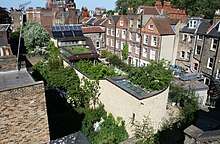 The Muse |
London, UK | Ongoing self-build, started 2004 |
|
| Welsh Futureworks Housing (Larch House and Lime House)[10] | 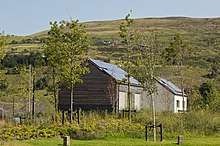 Welsh Futureworks Housing (Larch House, left, and Lime House, right) |
Ebbw Vale, Wales | 2010 | |
| Mayville Community Centre[13] | 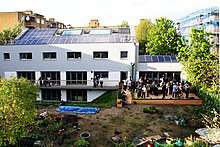 Mayville Community Centre |
London, UK | 2011 | |
| Lark Rise | 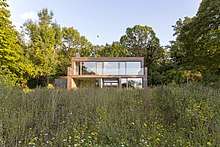 Lark Rise |
Buckinghamshire, UK | 2015 |
|
| London Bridge Staircase[18] | 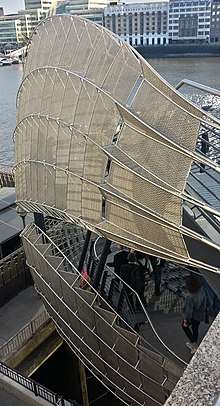 London Bridge Staircase |
London, UK | 2016 |
Publications
- An Introduction to Passive House, 2013
- The monitored performance of the first new London dwelling certified to the Passive House standard, Ian Ridley, Justin Bere, Alan Clarke, Yair Schwartz, Andrew Farr, 2013
- The Side by Side in use Monitored Performance of two Passive and Low Carbon Welsh Houses, Ian Ridley, Justin Bere, Hector Altamerino Medina, Sarah Lewis, Mila Durdev, 2014
References
- Miles, Paul (14 February 2014). "How a Brooklyn brownstone became a low-energy passive house". Financial Times. Retrieved 17 September 2014.
- "41-50 of the most influential people in UK sustainability". Building Design. 12 March 2012. Retrieved 15 October 2014.
- http://www.fourthdoor.co.uk/unstructured/unstructured_05/sitelines/passivhaus_bere.php
- "Project Gallery". passivhaustrust.org.uk. Retrieved 2017-12-11.
- "The Sustainable Futures Group". Vimeo. Retrieved 2017-12-11.
- Conference proceedings. Feist, Wolfgang. [S. l.: s. n.] 2011. ISBN 9783000343964. OCLC 780664199.CS1 maint: others (link)
- 16th International Passive House Conference 2012 : conference proceedings. Feist, Wolfgang., Passive House Institute (Darmstadt, Germany), International Passive House Conference (16th : 2012 : Hannover, Germany). Darmstadt: Passive House Institute. 2012. ISBN 9783000377204. OCLC 817936289.CS1 maint: others (link)
- "CIBSE Building Performance Awards Judging Panel". CIBSE. Retrieved 2017-12-11.
- "Green Building Case Studies in Islington and Beyond" (PDF). Islington Council. 2011. Retrieved 15 October 2014.
- "Welsh future Homes – The Larch House and Lime House – Design Commission for Wales". dcfw.org. Retrieved 2017-12-11.
- "Low Energy Buildings Projects". passivhausbuildings.org.uk. Retrieved 2017-12-11.
- "Low Energy Buildings Projects". passivhausbuildings.org.uk. Retrieved 2017-12-11.
- "Passivhaus community centre: Mayville by Bere Architects". Architects' Journal. 23 February 2012. Retrieved 17 September 2014.
- "Low Energy Buildings Projects". passivhausbuildings.org.uk. Retrieved 2017-12-11.
- "AJBL - bere:architects". www.ajbuildingslibrary.co.uk. Retrieved 2017-12-11.
- Consulting, E-Griffin. "Construction Project Work | E-Griffin Consulting | Cambridgeshire, UK - E-Griffin Consulting". www.e-griffin.uk. Retrieved 2017-12-11.
- "Passivhaus News". passivhaustrust.org.uk. Retrieved 2017-12-11.
- "London Bridge staircase enhancement works - City of London". www.cityoflondon.gov.uk. Retrieved 2017-12-11.